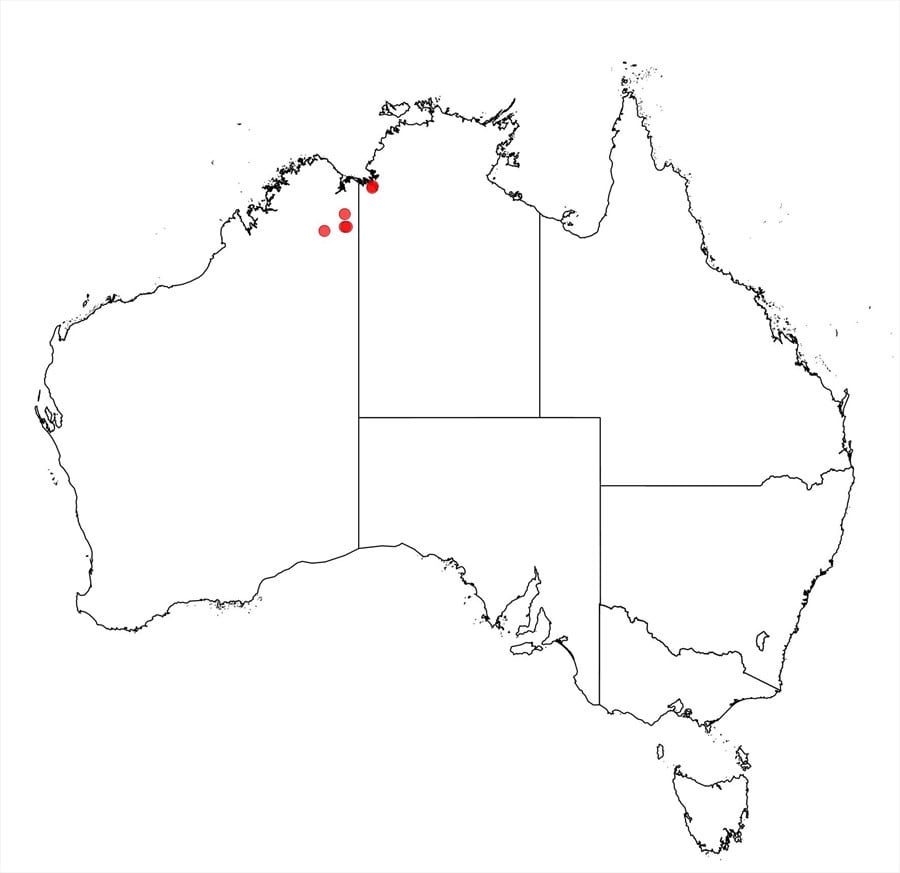Acacia claviseta Maslin, M.D.Barrett & R.L.Barrett
WATTLE
Acacias of Australia
Common Name
Club-tipped Whorled Wattle
Family
Fabaceae
Distribution
Occurs in the E Kimberley region of northern W.A. to the S of Kununurra where is known from a few scattered localities on Bedford Downs Stn, the Osmond Ra. and near Pompeys Pillar, N of Warmun; also occurs in Keep River Natl Park, N.T., c. 100 km NE of Kununurra.
Description
Erect, much-branched, slightly viscid shrub normally 0.6–0.8 m tall. Branchlets densely pilose to pubescent, the hairs pale yellow aging white. Stipules setose, (1–) 1.5–2.5 mm long. Phyllodes 9–16 per whorl, crowded, (3–) 4–7 (–8) mm long (excluding mucro), 0.3–0.4 mm wide, erect to ascending, terete to ±flat, puberulous; longitudinal nerves ±not visible; mucro narrowly clavate, (0.5–) 1–1.5 mm long and yellow to light brown, or setose (not clavate) and (0.2–) 0.3–0.5 mm long. Peduncles 15–30 mm long, ±densely pilose with pale golden or sometimes white hairs; heads 30–42-flowered. Bracteoles c. 3 mm long, the laminae caudate to long-acuminate. Sepals c. ½ length of petals, variably dissected for ¼–¾ their length into 5–7, ±oblong lobes that are golden-hairy at their apices; petals 5, ±obscurely striate, with pale yellow hairs at apices. Pods sessile, 10–35 mm long, 6–8 mm wide, flat but ±slightly raised over seeds along midline, glabrous, reticulately nerved. Seeds longitudinal, irregularly obloid to ellipsoid, 4–5.5 mm long, areole small (0.5–1 × 0.4–0.7 mm) and normally ‘u’-shaped, aril clavate.
Phenology
Flowers Feb.-Mar and July.-Aug.; mature pods commonly co-occur with flowers.
Habitat
Grows on top of sandstone ridges, on sand flats and shallow sand lenses among sandstone boulders and on scree slopes.
Specimens
W.A.: [localities withheld for conservation reasons] A.C.Beauglehole 53684 (BRI n.v., PERTH); K.F.Kenneally & B.P.M.Hyland KFK 10731 (DNA, PERTH). N.T.: I.D.Cowie 12097 (B n.v., BRI n.v., DNA n.v., MEL n.v., MO n.v., PERTH).
Notes
Appears most closely related to A. anasilla and A. lycopodiifolia which are most readily distinguished by their indumentum comprising white (never yellow) hairs, normally non-clavate phyllode setae and shorter calyces (clearly < ½ the length of the corolla) with short, linear to narrowly triangular lobes. Specimens of A. claviseta with phyllodes having short, non-clavate setae may superficially resemble A. capillaris which is distinguished by its longer stipules, short, glabrous calyx and its indumentum of white hairs. Acacia claviseta also appears to have some affinities with A. prolata.
The distinctive narrowly clavate setae that are normally 1–1.5 mm long commonly occur on youngest phyllodes; however, with age the terminal swollen portion of the trichome is lost and the phyllodes are then terminated by a fine setose point mostly 0.3–0.5 mm long. Many specimens are dimorphic for this character. The yellow hairs that are normally found on the branchlets, phyllodes and peduncles often impart a faint but discernible yellowish tinge to the plants.
Conservation
Acacia claviseta is listed as Priority Three under Department of Parks and Wildlife Conservation Codes for Western Australian Flora.
FOA Reference
Flora of Australia Project
Author
B.R.Maslin
This identification key and fact sheets are available as a mobile application:
URL: https://apps.lucidcentral.org/wattle/
© Copyright 2018. All rights reserved.






